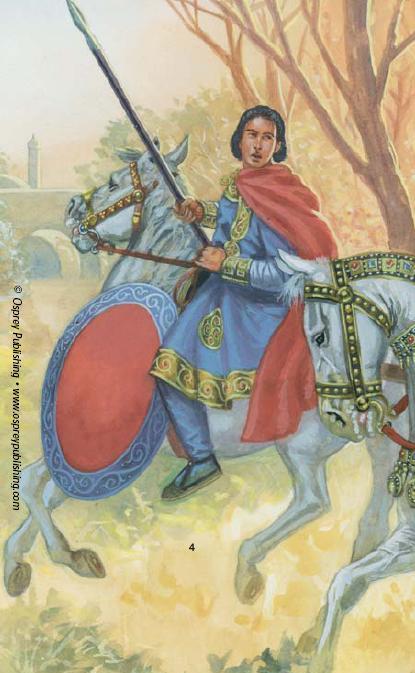|
|
Commentaries of Gregory of Nazianzus, Byzantine, 879-883AD
f.440r 1 Dream of Constantine / 2 Battle of Milvian Bridge (312AD) /
3 Saint Helena and councilors / 4 Invention of the holy cross

A larger image of the stories of Constantine and St. Helena, f.440r, 'Commentaries of Gregory of Nazianzus', Byzantine, BnF Grec 510
1 songe de constantin
2 bataille du pont milvius (312)
3 s. hélène et conseillers 4 invention de la sainte croix
Titre : Grégoire de Nazianze, manuscrit dédié à l'empereur Basile Ier le Macédonien.
Date d'édition : 0879-0883
Type : manuscrit
Langue : Grec
Format : Parchemin. - 465 fol. - Onciale. - Peint. - 435 x 300 mm
Description : gregorius thaumaturgus (s.), metaphrasis in ecclesiasten
Miniature au folio 440v. Registre supérieur : le rève de Constantin. Registre médian : la vision de la croix et la bataille du Pont Milvius. Registre inférieur : Hélène et l’invention de la croix.
Miniature on folio 440v. Upper register: the dream of Constantine. Middle: the vision of the cross and the battle of the Milvian Bridge. Lower register: Helen and the invention of the cross.
Source : Bibliothèque nationale de France, Département des manuscrits, Grec 510
Folio 440r presents Constantine's dream, his vision of the cross at the Milvian bridge, and Helena's discovery of the true cross in Jerusalem.
The top register, devoted to the dream, shows a nimbed Constantine, wearing a diadem surmounted by a small pearled cross,
asleep on a red cushion laid on a gold bed draped with a purple and gold cloth.
His purple mantle is drawn up around his upper body, revealing a pale blue undertunic with gold decoration worn over purple leggings.
Constantine's position duplicates the standard sleeping formula found throughout Paris.gr.510: he reclines with crossed legs,
his right arm thrown across his body and with his head resting on his left hand exactly like Jonah on f.3r and Jacob on f.174v.
On the right, two youthful guards, both in pale blue tunics decorated with gold under red cloaks, stand in relaxed poses, leaning on their lances and red shields.
The inscription to the scene, in the upper left-hand corner against the blue sky, has been almost entirely effaced; fragments of Constantine's name are all that remain.
In the middle register, Constantine, now wearing purple and gold under a red mantle that streams behind him,
charges toward the Milvian bridge on his white horse and lances Maxentius, in blue, who falls from his black horse as his army flees off to the right.
The cross, with pearl serifs, sits against a pale green orb and bears the famous inscription ΕΝ ΤΟΥΤΩ ΝΙΚΑ.
The lowest register contains two scenes. On the left, Helena sits on a jewelled lyre-back throne.
She is clad as a Byzantine empress, and retains the coiffure interwoven with pearls beneath a complex crown topped with a pearl cross that she wears on f.285r; on f.440r,
however, a purple cloak with gold and jewelled borders hides her undergarments.
Helena rests a blue orb surmounted by a cross on her lap, and gestures to a group of men who stand in the far left corner.
Though badly flaked, the foremost of the men toward whom she gestures appears to wear clerical garb and may be identified as Makarios,
bishop of Jerusalem, who helped Helena determine which of the three crosses she unearthed belonged to Christ.
Only Helena, however, is identified by inscription: Η ΑΓΙΑ ΕΛΕΝΗ.
To the right of the empress, two men carrying jewelled batons stand guard; they closely resemble the guards attending Theodosios on f.239r.
In the final scene, the standing Helena gestures toward a pit;
a man identical with the one identified as Makarios in the preceding scene kneels alongside and reaches toward the cross within it,
while a gesticulating group of onlookers cheer him on.
The scene is identified by inscription as the 'finding of the true cross' (EYPECIC TOY TIMIOY CTAYPOY),
and the same legend is repeated on the outer margin of the page in what appears to be ninth-century slanting uncial.
Source: pp. 163-164, Vision and Meaning in Ninth-Century Byzantium by Leslie Brubaker
The left of the lower register is referenced on p.27, Byzantine Imperial Guardsmen 925-1025: The Tághmata and Imperial Guard by Timothy Dawson
Constantine and St Helen. This detail from a miniature of c. AD 880 represents the Eunuch Spatharokouvikoulárioi;
both they and the Maghlavítai of the Imperial Guard were armed with their gold-hilted spathia during ceremonies and receptions.
The former are shown here carrying them over the shoulder, while the latter wore their swords from the belt. (Cod. Par. Gr. 510, folio 440v)
|
|


